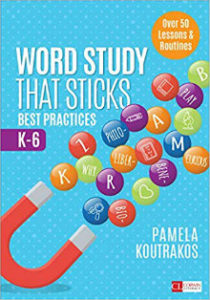How to Make Sure Your Word Study Sticks
Word Study That Sticks: Best Practices K-6
By Pamela Koutrakos
(Corwin Literacy, 2018 – Learn more)

“Words are a gateway to sharing our voices. Words allow us to be heard and allow us to listen to and, perhaps, better understand others. Through words, our stances and choices become clear. Through words, we have the chance to come together, even when we have distinct beliefs and philosophies. To this end, there is a clear and compelling need for systematic, thoughtful word study instruction.”

Koutrakos starts out Chapter One by admitting that there are a lot of books out there about word study. So why choose this one? Well, she says that the “key to successful word study is to keep it about playfulness and peer interaction,” and this book will show us how to do that.
I think she’s done it!
In the introduction, Koutrakos describes the resources included in the book, such as personalized and differentiated instruction, developmentally appropriate routines, and instruction in all aspects of word study. She also includes practical ideas for you to include word study into different parts of your day (to achieve more transfer of student learning), an easy-to-implement approach, and built-in professional development.
Flexible possibilities
Another great tool in the introduction is the “How to Use This Book With Other Programs or as Your Sole Resource” section. So, whether you currently have a word study program in place but think there’s something missing – or you’re making it up as you go – this book is for you!
One thing we need to get out of the way is – what is word study? I’ve noticed sometimes teachers just replace “spelling” with “word study” because (maybe?) it sounds more “balanced literacy-like”??
Obviously, it’s the study of words. But it’s the “study of words in all kinds of ways…sounds, letters, and spelling patterns.” And it’s also “thinking about meaning, connections, connotation, usage, and the impact of words.” Koutrakos points out that a well-rounded approach to word study incorporates phonemic awareness, phonics, spelling, and vocabulary, and she focuses on how to start up and step up all of these important parts.
The ultimate goal of any word study program is for students to increase their knowledge of how words work—to develop a knowledge of spelling patterns and be able to apply those patterns to new words, and to develop a knowledge of word meanings and how meaning impacts that word knowledge.
You can pick the part that suits your current need
This book is written in three parts. You may decide to start at the beginning and read it cover to cover. However, it’s written so that you can choose the part you need and focus there, if you so desire.
Koutrakos highlights each of the three parts in the introduction, so you can familiarize yourself with the structure and format before you begin. She also previews the features of the book, such as the “Inviting Inquiry” feature which lists questions and prompts (in language you can use) to promote student curiosity and discovery around words.
There’s a chapter on finding the time and resources to get started, and one on launching your word study. This one has 10 lessons plus a bonus lesson all ready for you to launch your word study program! Chapter Four is about assessment. This isn’t just the old “end-of-the-unit”-type assessment, but authentic self-assessment and reflection, turning noticings into teachings, and student choice. There are ready-made lessons that will help you see where your students are and make decisions for next steps.
Lessons to fit across content areas
Chapters Six and Seven have more ready-to-go lessons for student practice and support, as well as all of the added features mentioned above. Chapter Eight is about “Releasing Responsibility,” so the lessons in this chapter focus on goal setting and reflection.
Chapters Nine and Ten assist you in seeing how word study fits into every part of your day, such as shared reading, shared writing, math, science, and social studies; it’s not just a small part of study before you move on to something else!
The appendices at the back have book titles of word-rich books, quotes about words, and sample checklists. She also provides several sample schedules so you can see how word study centers can fit into your already jam-packed day!
Online printable and reproducible resources are available at resources.corwin.com/wordstudythatsticks. If you’re on Twitter, you can follow Koutrakos @PamKou. She recently had a Twitter chat about word study. You can look it up at #rrchat.
If I had to choose one word to describe this book about words, I’d choose “fabulous”! It’s also practical, teacher-friendly, and colorful. Get your copy today!
Pam Hamilton is an intermediate literacy coach at Middlebury Community Schools in Middlebury, Indiana. She loves being able to support teachers in their literacy teaching and learning!

































